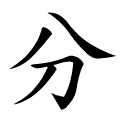分
- to divide, to separate, to apportion;
Etymology
Formed as a phono-semantic compound (sometimes also seen as pictographic/ideographic):
刀 (knife, 刂) — semantic element, symbolizing cutting or dividing.
八 (to split, divide, separate) — graphic component, showing divergence.
Together they depict the act of cutting apart into portions, hence “to divide.”
Semantic range:
- to divide, separate, distinguish (나누다, 가르다);
- portion, share, part (분량, 일부);
- role, duty, position, status (신분, 성분);
Unit of measurement:
- time — minute (1/60 of an hour);
- currency — 1/100 of a yuan, yen, or won;
- degree — fraction, score, percentage (점수).
Usage in Korean
분할 (分割) — division, partition
부분 (部分) — a part, section
신분 (身分) — social status, identity
성분 (成分) — ingredient, composition
기분 (氣分) — mood, feeling
점수/득점 (得分) — score, points
분명 (分明) — clear, distinct
시간 단위 — 10분 (十分钟 “ten minutes”)
화폐 단위 — 1분 = 1/100 of currency unit
Words that derived from 分
- 구분(區分)–categorization; classification
- 본분(本分)–duty
- 부분(部分)–part
- 분(分)–minute
- 분계선(分界線)–line of demarcation
- 분권(分權)–decentralization
- 분담(分擔)–share
- 분류(分類)–sorting; classification
- 분리(分離)–separation
- 분립(分立)–separation; schism
- 분명(分明)–clearly; surely
- 분명하다(分明하다)–distinct; clear; apparent; evident; indisputable
- 분명히(分明히)–clearly; firmly; surely
- 분배(分配)–allocation; allotment
- 분석(分析)–analysis
- 분열(分裂)–division; split; schizophrenia
- 분점(分店)–branch
- 분할(分割)–division
- 분할되다(分割되다)–be divided; be partitioned
- 분화(分化)–division; segmentation
- 사탄 분립기대(사탄 分立基臺)–the foundation of having separated Satan
- 신분(身分)–status; rank; position
- 영양분(營養分)–nourishment; nutrient
- 정분(情分)–affection; love
- 정분합(正分合)–origin-division-union
- 정분합작용(正分合作用)–origin-division-union action
- 직분(職分)–duty
- 책임분담(責任分擔)–portion of responsibilitye
Additional notes
In Confucian thought, 分 often conveys the idea of proper roles and distinctions within social and moral order. For instance, 君子 (junzi, “the noble person”) acts “according to his 分” — fulfilling one’s allotted role and responsibility. The phrase 安分 (안분, to be content with one’s station) reflects the Confucian virtue of knowing one’s proper place.
Thus 分 extends beyond physical division to embody the principle of cosmic and social differentiation, where harmony arises when each part fulfills its role.
